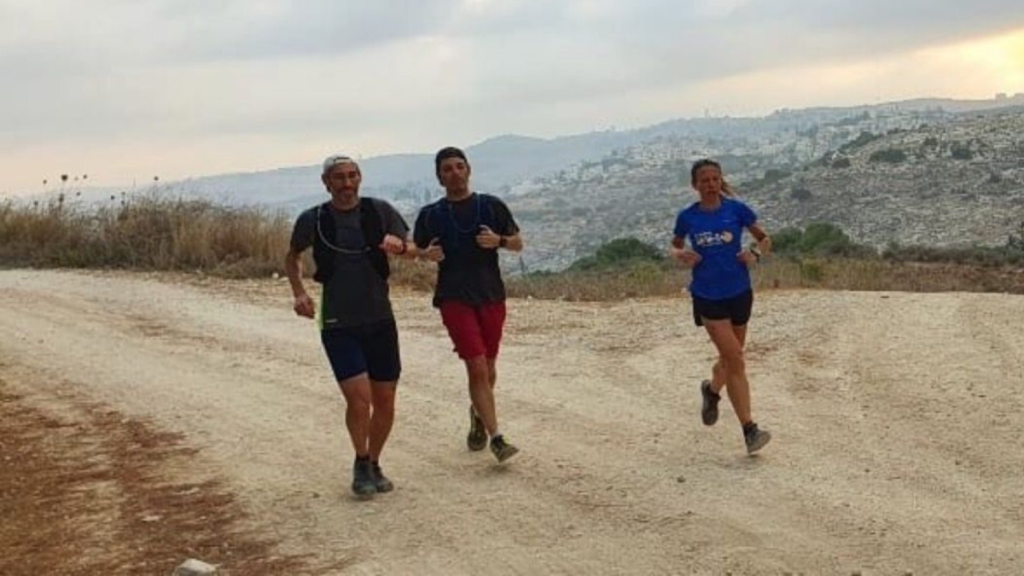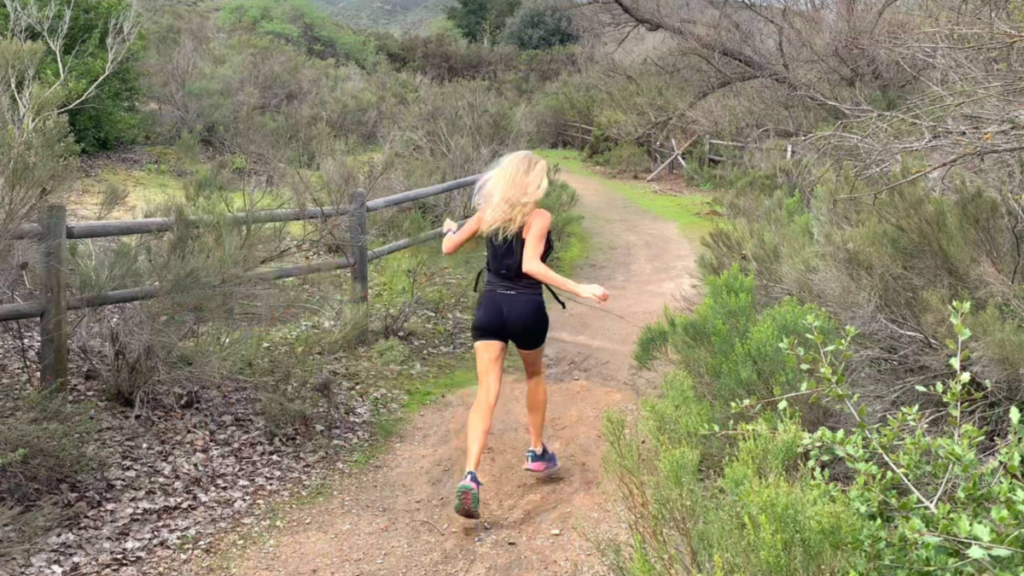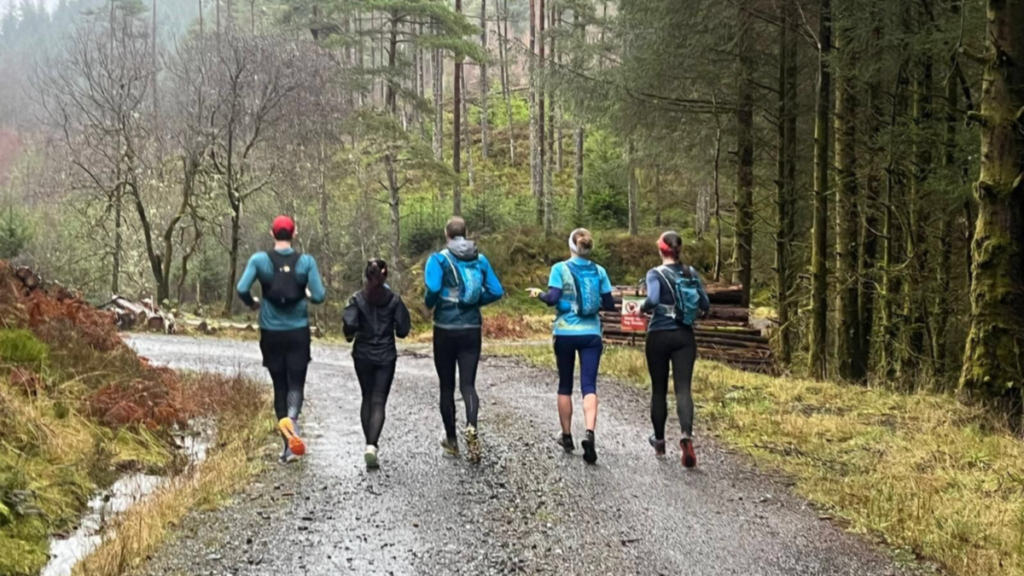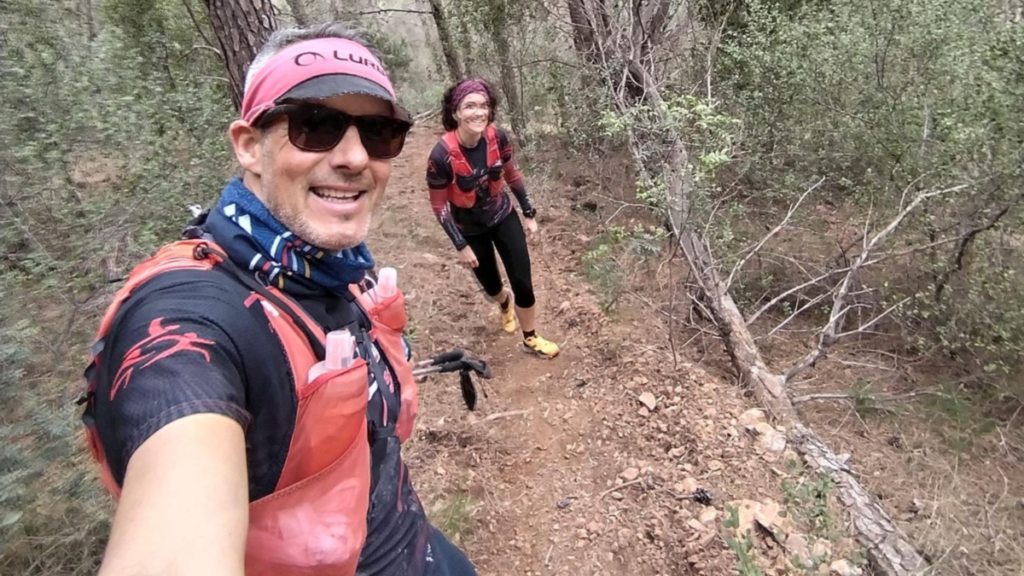
Most of the runners that I speak to about trail running are apprehensive because they don’t want to go to the expense of buying trail-specific equipment if they don’t know how much they will enjoy the trails. My tips are always the same – revolving around choosing shorter routes on less technical terrain. It is possible to run these easier trails in road shoes as well as all your other existing running kit. So, the only thing holding you back from trying trail running is your own fear.
As a beginner trail runner, start with shorter, less technical routes so that you can start getting used to running on an uneven surface. These beginner-level trails are also perfect as you can use your road shoes when trying out trails for the first time. No expensive equipment is needed.
Let’s take a deeper dive into all the tips for beginner trail runners so that you can step out onto the trails in confidence and enjoy whet nature has to offer.
Trail Running Tips for Beginners
Trail running offers a thrilling escape into nature, providing a refreshing change from the monotony of road running. For beginners, it’s essential to understand the distinct challenges and rewards that come with hitting the trails. Unlike the predictable pavement, trails present uneven terrain, varying elevations, and obstacles like rocks and tree roots.
To navigate these challenges successfully, beginners should start with shorter, less technical trails to build confidence and gradually progress to more challenging routes. It’s crucial to focus on proper foot placement, maintaining a steady pace, and being mindful of your surroundings to prevent injuries and enjoy the experience to the fullest.
Additionally, trail running requires a different mindset than road running. Embrace the unpredictability of nature, listen to the sounds of the wilderness, and savor the scenic views along the way. By immersing yourself in the natural environment, you’ll not only improve your physical fitness but also nourish your mental well-being.
Remember, trail running is not just a workout; it’s an adventure waiting to unfold. So lace up your shoes, hit the trails, and discover the joy of running in the great outdoors.
Essential Gear for Trail Running
When it comes to trail running, having the right gear can make all the difference in your experience. To ensure safety and comfort on the trails, it’s essential to invest in quality equipment and clothing.
First and foremost, a reliable pair of trail running shoes is a must-have. Look for shoes with good traction, stability, and support to navigate varying terrains with ease. Additionally, moisture-wicking socks will help keep your feet dry and prevent blisters.
Another crucial piece of gear is a hydration pack or water bottle to stay hydrated during your runs. Opt for a pack that fits comfortably and has enough capacity for longer runs. Don’t forget to pack energy gels or snacks for refueling on the go.
In terms of clothing, choose moisture-wicking and breathable fabrics to stay dry and comfortable. Dress in layers to adapt to changing weather conditions and consider wearing a hat and sunglasses for sun protection.
Lastly, a lightweight and compact first aid kit should always be part of your gear to handle minor injuries or emergencies on the trail. By being prepared with the right gear, you can focus on enjoying the beauty of nature and the thrill of trail running.
Choosing the Right Trail
When it comes to choosing the right trail for your trail running adventures, beginners should consider several factors to ensure an enjoyable and safe experience.
First and foremost, assess the difficulty level of the trail. Beginners should start with easy or moderate trails that match their current fitness level and running experience. Look for trails with gentle inclines and well-marked paths to build confidence and avoid unnecessary challenges.
Next, consider the terrain of the trail. Opt for trails that align with your comfort level and skill set. Some beginners may prefer smoother, wider paths, while others might enjoy more technical terrain with rocks, roots, and obstacles to navigate. Choose a trail that excites you but also respects your current abilities.
Lastly, take into account the distance of the trail. Beginners should start with shorter distances and gradually increase their mileage as they build endurance and strength. Look for trails with loop options or easy access to aid stations for added convenience.
By carefully selecting trails based on difficulty level, terrain, and distance, beginners can set themselves up for a positive trail running experience and gradually progress to more challenging routes as they improve their skills and fitness.
Warm-Up and Stretching Routine
Before hitting the trails for your trail running session, it is crucial to prioritize a proper warm-up and stretching routine. Warming up helps increase blood flow to your muscles, preparing them for the physical activity ahead. This can enhance your performance, prevent injuries, and improve flexibility. Incorporating dynamic stretches like leg swings, arm circles, and high knees can help loosen up your muscles and joints.

Stretching is equally important as it helps improve your range of motion and flexibility, reducing the risk of strains and muscle imbalances. Focus on stretching major muscle groups such as hamstrings, quadriceps, calves, and hip flexors. Hold each stretch for about 15-30 seconds without bouncing to avoid injury.
By dedicating time to warm up and stretch properly before your trail run, you can enhance your overall performance, prevent injuries, and ensure a more enjoyable running experience. Remember, taking care of your body through proper warm-up and stretching routines is essential for long-term success in trail running.
Technique Tips for Uphill Climbs
Transitioning from downhill descents to uphill climbs requires a shift in technique and mindset. When tackling uphill sections during your trail run, it’s crucial to focus on maintaining efficient form and conserving energy to conquer the incline effectively. To optimize your uphill running technique, remember to lean slightly forward from your ankles, engaging your core for stability and balance. This posture helps you propel yourself forward and upward with each step.
Another essential tip is to take shorter, quicker steps to maintain momentum and reduce the strain on your muscles. By doing so, you can distribute the workload more evenly and prevent early fatigue. Additionally, focus on your breathing pattern, inhaling deeply through your nose and exhaling fully through your mouth to supply your muscles with oxygen efficiently.
To conserve energy on uphill climbs, consider using your arms to assist your leg movements. Pumping your arms in sync with your steps can provide an extra power boost and help you tackle steeper inclines with greater ease. By implementing these technique tips and strategies, you can enhance your uphill running performance and build confidence in conquering challenging terrain during your trail runs.
Technique Tips for Downhill Descents
Transitioning from uphill climbs to downhill descents requires a shift in technique and mindset to navigate the terrain safely and confidently. When tackling downhill sections during your trail run, it’s essential to focus on controlling your speed while maintaining balance and stability. To optimize your downhill running technique, lean slightly back from your ankles to prevent tumbling forward and engage your core for control.
One crucial tip is to focus on shortening your stride and increasing your cadence to manage your speed effectively. By taking quicker, lighter steps, you can react faster to obstacles and changes in terrain, reducing the risk of injury. Additionally, keep your eyes focused a few steps ahead to anticipate the path and adjust your footing accordingly.
Utilizing your arms for balance and momentum is another valuable strategy for navigating downhill descents. By keeping your arms slightly out to the sides and swinging them in coordination with your steps, you can enhance stability and control while descending steep slopes. Implementing these technique tips and strategies will help you build confidence in tackling downhill terrain and enjoy a smoother, more controlled trail running experience.
Pacing Strategies for Long Runs
Transitioning from shorter trail runs to longer distances requires a strategic approach to pacing in order to maintain energy levels and endurance. When tackling long runs on trails, it’s crucial to find a sustainable pace that allows you to cover the distance without burning out too quickly. One effective pacing strategy is to start at a comfortable pace that you can maintain for the duration of the run, focusing on conserving energy for later stages.
Another key technique is to incorporate walk breaks strategically, especially during challenging uphill sections or when fatigue starts to set in. By alternating between running and walking, you can give your muscles a chance to recover and prevent early exhaustion. Additionally, practicing negative splits, where you gradually increase your pace throughout the run, can help you finish strong and avoid hitting a wall towards the end.
Monitoring your heart rate and paying attention to your breathing can also guide your pacing decisions during long trail runs. By staying within your aerobic zone and adjusting your speed accordingly, you can prevent overexertion and maintain a steady rhythm. Implementing these pacing strategies will not only improve your performance on long runs but also enhance your overall trail running experience.
Hydration and Nutrition Guidance
Transitioning from shorter trail runs to longer distances brings a new level of importance to hydration and nutrition. Properly fueling your body during trail runs is essential for maintaining energy levels and performance, especially in diverse environments. Staying hydrated is crucial to prevent dehydration and maintain optimal physical function. Carrying a hydration pack or water bottle is recommended to ensure access to fluids throughout your run.

In addition to hydration, fueling your body with the right nutrition is key to sustaining energy levels during long trail runs. Pack lightweight, nutrient-dense snacks like energy bars, nuts, or dried fruits to refuel on-the-go. Consider the duration and intensity of your run when planning your nutrition strategy to avoid hitting the wall due to low energy levels.
By prioritizing hydration and nutrition, you can enhance your trail running experience and performance. Experiment with different hydration and nutrition plans during training runs to find what works best for you. Remember, staying properly fueled and hydrated will not only improve your physical performance but also contribute to a safer and more enjoyable trail running experience.
Safety Precautions and Emergency Preparedness
Transitioning into trail running requires a heightened awareness of safety precautions and emergency preparedness. As a beginner, it’s crucial to prioritize your safety by carrying essential items such as a first aid kit and knowing how to handle emergencies effectively.
A well-equipped first aid kit should include items like bandages, antiseptic wipes, blister pads, and any personal medications you may need. Knowing how to use these items can make a significant difference in addressing minor injuries or discomfort while on the trail.
In addition to carrying a first aid kit, familiarize yourself with basic emergency protocols. Understanding how to navigate common emergencies such as getting lost, encountering wildlife, or dealing with sudden weather changes is essential for your safety. Consider carrying a whistle or signaling device to attract attention if needed.
By proactively preparing for potential risks and emergencies, you can enjoy your trail running experience with greater peace of mind. Remember, safety should always be a top priority when exploring new trails and pushing your limits as a beginner trail runner.
Leave No Trace Principles
Transitioning into trail running involves more than just physical preparation; it also requires a mindset of environmental stewardship. “Leave No Trace” principles are essential for minimizing our impact on the natural world while enjoying the trails. By following these ethics, trail runners can help preserve the beauty of the outdoors for future generations.
One key principle is to “pack it in, pack it out,” meaning that whatever you bring onto the trail should be taken back with you. This includes not only your trash but also any food wrappers or other waste. Additionally, staying on designated trails helps protect fragile ecosystems and prevents soil erosion.
Another important aspect of Leave No Trace is respecting wildlife by observing from a distance and not feeding or approaching animals. By keeping a safe distance, we can minimize our impact on their natural behaviors and habitats.
By incorporating Leave No Trace principles into your trail running routine, you can contribute to the conservation of natural spaces and ensure that these environments remain pristine for all to enjoy. Practicing environmental stewardship is not just a responsibility but a way to show appreciation for the beauty of the outdoors.
Trail Etiquette and Courtesy
Transitioning into trail running involves more than just physical preparation; it also requires a mindset of environmental stewardship. “Leave No Trace” principles are essential for minimizing our impact on the natural world while enjoying the trails. By following these ethics, trail runners can help preserve the beauty of the outdoors for future generations.
When it comes to trail etiquette and courtesy, it’s crucial to be mindful of other trail users. Always yield to hikers and slower runners, announcing your presence in a friendly manner as you approach. Keeping to the right side of the trail allows for smoother passing and prevents congestion.
Additionally, controlling your speed on descents is important to avoid startling others or causing accidents. Be sure to share the trail responsibly with fellow outdoor enthusiasts, respecting their space and right to enjoy the surroundings peacefully.
By adhering to trail etiquette guidelines, you not only ensure a positive experience for yourself but also contribute to a harmonious environment for all trail users. Remember, a little courtesy goes a long way in fostering a sense of community and respect among those who share the trails.
Dealing with Wildlife Encounters
Transitioning into trail running also means being prepared to encounter wildlife along the way. It’s essential to respect the natural habitats of animals and know how to react in various situations. When facing wildlife on the trails, remember to remain calm and avoid sudden movements.

One important tip is to make noise while running to alert animals of your presence and avoid surprising them. This can help prevent unexpected encounters and reduce the risk of startling wildlife. Additionally, it’s crucial to give animals their space and not approach or feed them.
In the event of encountering larger wildlife, such as bears or mountain lions, it’s important to stay calm, avoid direct eye contact, and slowly back away while making yourself appear larger. Knowing how to react in these situations can help ensure your safety and the well-being of the animals.
By being aware of wildlife encounters and following these tips, trail runners can enjoy their outdoor experience while respecting the natural environment and its inhabitants. Remember, coexisting peacefully with wildlife is key to preserving the beauty and balance of the trails for everyone to enjoy.
Listening to Your Body: Signs of Overexertion
Transitioning into trail running can be an exhilarating experience, but it’s crucial to listen to your body along the way. Recognizing signs of overexertion is essential for beginners to prevent fatigue or injury. Common signs to watch out for include persistent pain, extreme fatigue, dizziness, nausea, or shortness of breath. If you experience any of these symptoms, it’s important to take a step back, rest, and assess your condition.
Ignoring these signs can lead to more serious issues and hinder your progress in trail running. Remember, rest is just as important as training to allow your body to recover and adapt to the demands of the sport. If symptoms persist or worsen, don’t hesitate to seek medical attention to prevent any potential long-term consequences.
By being in tune with your body and understanding its signals, you can ensure a safe and enjoyable trail running experience. Prioritize self-care, rest when needed, and always prioritize your health and well-being on the trails.
Setting Realistic Goals and Tracking Progress
Setting realistic goals is a fundamental aspect of your trail running journey. By establishing clear objectives, you can stay motivated and focused on your progress. When setting goals, it’s important to make them specific, measurable, achievable, relevant, and time-bound (SMART). Start with small milestones, such as completing a certain distance or improving your pace, and gradually increase the challenge as you progress.
Tracking your progress is key to monitoring your improvement and staying motivated. Consider using a running log or a fitness app to record your runs, distances, times, and how you felt during each session. This not only helps you track your achievements but also allows you to identify areas for improvement.
Celebrate your successes along the way, whether it’s reaching a new distance goal, improving your speed, or simply staying consistent with your training. Recognizing your accomplishments, no matter how small, can boost your confidence and keep you motivated to continue pushing yourself.
By setting realistic goals and actively tracking your progress, you can stay motivated, focused, and committed to your trail running journey. Remember, progress takes time, so be patient with yourself and celebrate every step forward.
Connecting with the Trail Running Community
Connecting with the trail running community can significantly enhance your trail running experience. By joining local trail running groups or online communities, you gain access to a supportive network of like-minded individuals who share your passion for the sport. These communities provide a platform for exchanging valuable advice, tips, and experiences, helping you improve your skills and knowledge about trail running.
Engaging with the trail running community also offers a sense of camaraderie and belonging. Whether you’re a beginner seeking guidance or a seasoned runner looking to connect with fellow enthusiasts, being part of a community can boost your motivation and enthusiasm for trail running. Sharing your achievements, challenges, and progress with others who understand and support your journey can be incredibly rewarding.
Moreover, participating in group runs or virtual challenges organized by the community can add a fun and social element to your training routine. It can also introduce you to new trails, training techniques, and even potential running buddies. Overall, connecting with the trail running community not only enriches your trail running experience but also fosters a sense of community and belonging within the sport.
